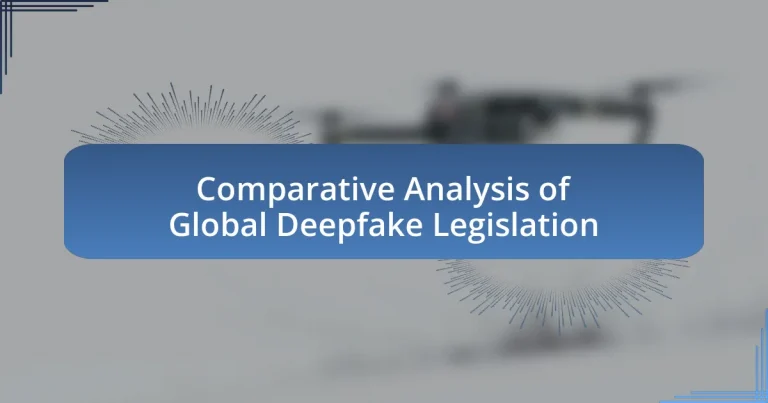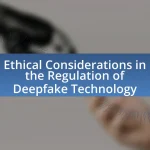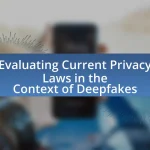Global Deepfake Legislation encompasses laws and regulations established by various countries to address the creation and distribution of deepfake technology, which generates realistic but false representations of individuals. This article provides a comparative analysis of deepfake legislation across different jurisdictions, highlighting the necessity of such laws in combating misinformation, protecting privacy, and preventing harm. Key components of these laws, potential harms associated with deepfakes, and the challenges faced by lawmakers in creating effective regulations are examined. Additionally, the article discusses the implications of deepfake legislation on freedom of expression and the role of international organizations in shaping these legal frameworks.
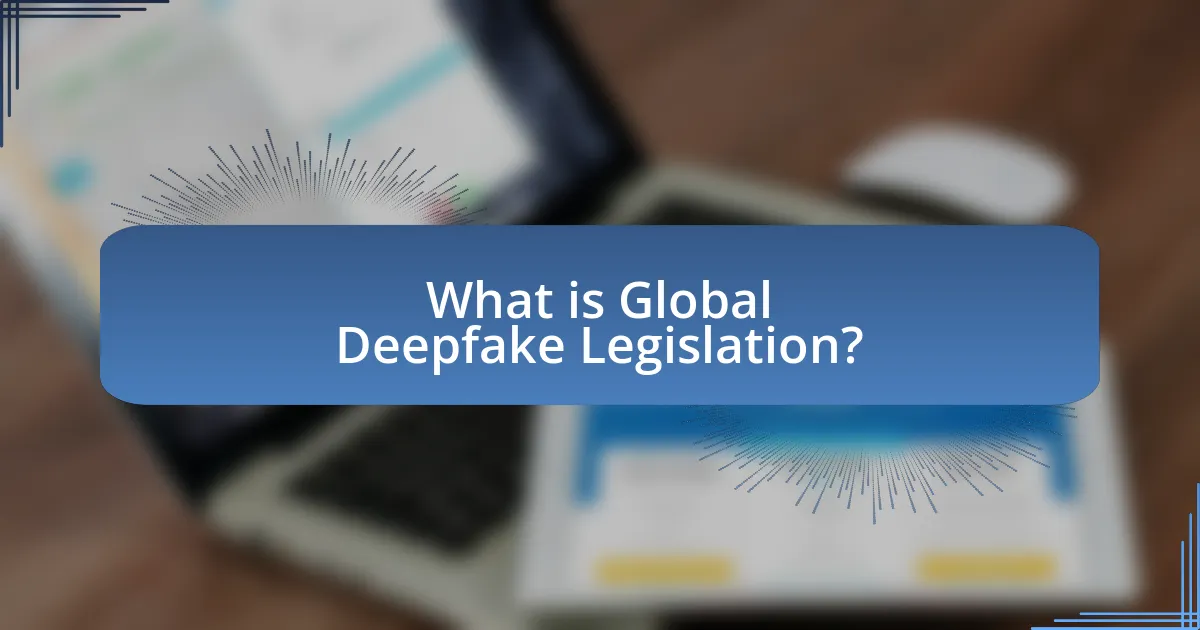
What is Global Deepfake Legislation?
Global Deepfake Legislation refers to laws and regulations enacted by various countries to address the creation and distribution of deepfake technology, which manipulates audio and visual content to create realistic but false representations of individuals. These legislative efforts aim to combat misinformation, protect individuals’ rights, and prevent potential harm caused by malicious uses of deepfakes, such as fraud, harassment, or defamation. For instance, the United States has introduced specific bills targeting deepfakes, while countries like the United Kingdom and Australia are also developing frameworks to regulate this technology, reflecting a growing global consensus on the need for legal measures against deepfake misuse.
Why is deepfake legislation necessary in today’s digital landscape?
Deepfake legislation is necessary in today’s digital landscape to combat the potential for misinformation, identity theft, and manipulation of public opinion. The rise of deepfake technology has made it increasingly easy to create realistic but false representations of individuals, which can lead to significant harm, including reputational damage and erosion of trust in media. For instance, a study by the Deepfake Detection Challenge found that deepfakes can be convincingly realistic, making it difficult for the average person to discern truth from fabrication. Furthermore, incidents of deepfakes being used in political campaigns and to create non-consensual explicit content highlight the urgent need for legal frameworks that can address these issues effectively.
What are the potential harms associated with deepfakes?
Deepfakes pose significant potential harms, including misinformation, reputational damage, and privacy violations. Misinformation can lead to the spread of false narratives, as deepfakes can convincingly alter reality, influencing public opinion and political outcomes. Reputational damage occurs when individuals are depicted in compromising or false scenarios, which can harm personal and professional relationships. Privacy violations arise when deepfakes are created without consent, exploiting individuals’ likenesses for malicious purposes, such as harassment or defamation. These harms are substantiated by instances where deepfakes have been used in political campaigns and celebrity scandals, demonstrating their capacity to disrupt societal trust and personal integrity.
How do deepfakes impact privacy and security?
Deepfakes significantly undermine privacy and security by enabling the creation of realistic but fabricated audio and visual content that can mislead individuals and organizations. This technology poses risks such as identity theft, where malicious actors can impersonate individuals for fraudulent purposes, and the spread of misinformation, which can damage reputations and influence public opinion. For instance, a study by the University of California, Berkeley, found that deepfake technology could be used to create convincing fake videos that could manipulate viewers, leading to potential security threats in political and social contexts. Additionally, the rise of deepfakes has prompted legislative responses worldwide, as governments recognize the need to protect individuals’ privacy rights and enhance security measures against such deceptive practices.
What are the key components of deepfake legislation?
Key components of deepfake legislation include definitions of deepfakes, regulations on the creation and distribution of deepfake content, provisions for consent from individuals depicted, penalties for malicious use, and guidelines for transparency in media. These components aim to address the potential harms of deepfakes, such as misinformation and privacy violations. For instance, California’s AB 730 law specifically targets the use of deepfakes in political campaigns and requires disclosure when deepfake technology is used.
What definitions and classifications are used in deepfake laws?
Deepfake laws typically define deepfakes as synthetic media in which a person’s likeness is altered or replaced with another’s likeness using artificial intelligence techniques. Classifications within these laws often categorize deepfakes based on intent, such as malicious deepfakes aimed at defamation or fraud, and benign deepfakes used for entertainment or artistic purposes. For instance, California’s AB 730 specifically addresses malicious deepfakes intended to harm or defraud individuals, while other jurisdictions may focus on the technology used or the context in which deepfakes are deployed. These definitions and classifications are crucial for establishing legal frameworks that address the potential harms associated with deepfake technology.
How do different jurisdictions approach the regulation of deepfakes?
Different jurisdictions approach the regulation of deepfakes through a combination of existing laws, new legislation, and specific guidelines. For instance, the United States has seen various states, such as California and Texas, enact laws targeting malicious deepfake use, particularly in the context of elections and pornography. In contrast, the European Union is working on comprehensive regulations under the Digital Services Act, which aims to address harmful content, including deepfakes, by imposing stricter accountability on platforms. Meanwhile, countries like China have implemented regulations that require deepfake creators to disclose the synthetic nature of their content, emphasizing transparency. These varied approaches reflect differing legal frameworks and cultural attitudes towards technology and misinformation, highlighting the complexity of regulating deepfakes globally.
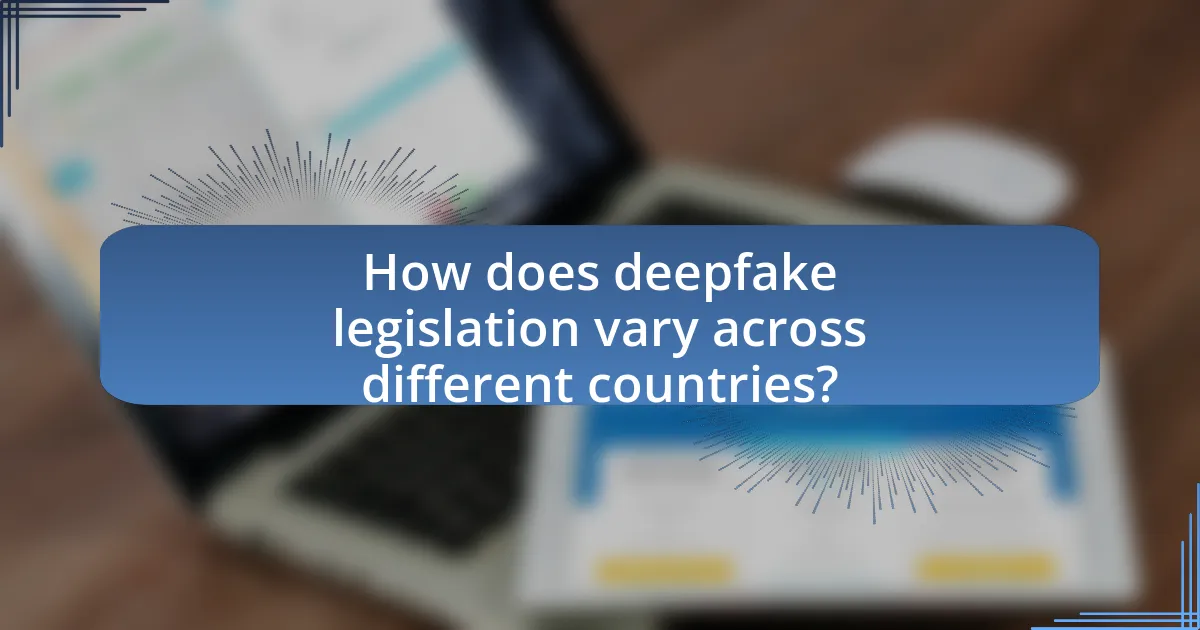
How does deepfake legislation vary across different countries?
Deepfake legislation varies significantly across countries, reflecting differing legal frameworks and societal concerns. For instance, the United States has no federal law specifically targeting deepfakes, but several states, such as California and Texas, have enacted laws addressing malicious deepfake use, particularly in the context of elections and pornography. In contrast, the European Union is working on comprehensive regulations under the Digital Services Act, which aims to tackle harmful content, including deepfakes, with a focus on accountability for platforms. Meanwhile, countries like China have implemented strict regulations that require deepfake creators to label their content clearly, emphasizing state control over digital media. This variation illustrates how cultural, political, and legal contexts shape the approach to deepfake technology globally.
What are the leading countries in implementing deepfake laws?
The leading countries in implementing deepfake laws are the United States, Canada, and the United Kingdom. The United States has enacted various state-level laws addressing deepfakes, particularly in the context of election integrity and non-consensual pornography. Canada has proposed legislation that includes provisions against deepfakes, emphasizing the protection of individuals from harmful digital content. The United Kingdom has also introduced measures to combat deepfakes, focusing on their potential misuse in fraud and misinformation. These countries are at the forefront of developing legal frameworks to address the challenges posed by deepfake technology.
How does the United States address deepfake technology legally?
The United States addresses deepfake technology legally through a combination of federal and state laws that target fraud, harassment, and misinformation. For instance, the Malicious Deep Fake Prohibition Act of 2018 proposed criminal penalties for using deepfakes to harm others, while several states, including California and Texas, have enacted laws specifically prohibiting the use of deepfakes for malicious purposes, such as defamation or election interference. These legal frameworks aim to mitigate the risks associated with deepfakes by establishing clear consequences for misuse, thereby reinforcing the importance of accountability in digital content creation.
What unique approaches have been taken by European countries?
European countries have implemented unique approaches to deepfake legislation by focusing on comprehensive regulatory frameworks and public awareness campaigns. For instance, the United Kingdom has proposed the Online Safety Bill, which aims to hold platforms accountable for harmful content, including deepfakes, while Germany has enacted the Network Enforcement Act, requiring social media companies to remove illegal content swiftly. Additionally, France has introduced measures to enhance transparency in media, mandating clear labeling of manipulated content. These legislative efforts reflect a proactive stance in addressing the challenges posed by deepfakes, emphasizing accountability and consumer protection.
What challenges do countries face in creating effective deepfake legislation?
Countries face significant challenges in creating effective deepfake legislation due to the rapid technological advancements and the complexity of defining harmful content. The evolving nature of deepfake technology makes it difficult for lawmakers to keep pace, as new methods for creating and distributing deepfakes emerge frequently. Additionally, legal definitions of misinformation and harm vary widely across jurisdictions, complicating the establishment of a universal legal framework.
Moreover, the balance between regulating deepfakes and protecting freedom of expression poses a dilemma for legislators, as overly restrictive laws could infringe on individual rights. Enforcement is another challenge, as identifying the creators of deepfakes can be difficult, and existing laws may not adequately address the unique aspects of this technology. These factors contribute to the slow development of comprehensive and effective deepfake legislation globally.
How do technological advancements complicate legislative efforts?
Technological advancements complicate legislative efforts by outpacing the ability of lawmakers to create effective regulations. For instance, the rapid evolution of deepfake technology has led to challenges in defining legal parameters, as existing laws often do not account for the unique characteristics of synthetic media. A study by the Brookings Institution highlights that the speed of technological change can result in regulatory gaps, where harmful applications of technology, such as misinformation or identity theft through deepfakes, are not adequately addressed by current legal frameworks. This discrepancy creates difficulties in enforcement and compliance, as legislators struggle to keep up with innovations that continuously alter the landscape of potential misuse.
What are the legal and ethical dilemmas surrounding enforcement?
Legal and ethical dilemmas surrounding enforcement of deepfake legislation include the challenges of defining harmful content and the potential for infringing on free speech rights. Enforcement agencies must navigate the fine line between protecting individuals from malicious deepfakes and upholding constitutional rights, as seen in cases where legislation may inadvertently criminalize legitimate artistic expression. Additionally, the rapid evolution of technology complicates enforcement, as laws may lag behind the capabilities of deepfake creation, leading to difficulties in identifying and prosecuting offenders. The lack of standardized definitions and varying legal frameworks across jurisdictions further exacerbate these dilemmas, making consistent enforcement problematic.
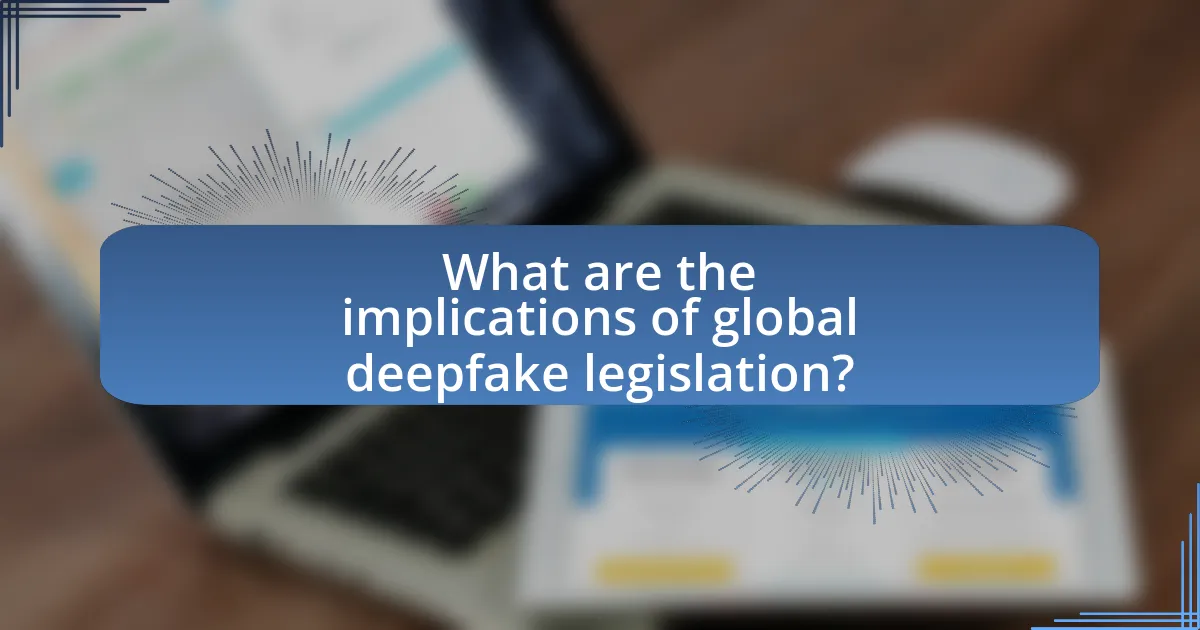
What are the implications of global deepfake legislation?
Global deepfake legislation has significant implications for privacy, security, and the media landscape. It aims to mitigate the risks associated with the misuse of deepfake technology, which can lead to misinformation, identity theft, and reputational damage. For instance, countries implementing such laws may see a reduction in the spread of harmful deepfakes, as legal frameworks provide avenues for accountability and enforcement against creators of malicious content. Additionally, these regulations can foster a more responsible use of artificial intelligence in media, encouraging ethical standards and practices. The establishment of global norms can also facilitate international cooperation in combating deepfake-related crimes, as seen in collaborative efforts among nations to address cyber threats.
How does deepfake legislation affect freedom of expression?
Deepfake legislation can restrict freedom of expression by imposing legal consequences on the creation and distribution of deepfake content. Such laws aim to prevent misinformation and protect individuals from harm, but they may also limit artistic expression, satire, and legitimate political discourse. For instance, in the United States, some states have enacted laws that criminalize malicious deepfakes, which can lead to self-censorship among creators concerned about legal repercussions. This tension between regulation and expression highlights the challenge of balancing public safety with the fundamental right to free speech, as seen in debates surrounding the First Amendment.
What balance must be struck between regulation and free speech?
The balance between regulation and free speech requires ensuring that laws protect individuals from harm while preserving the fundamental right to express opinions and ideas. Effective regulation should target harmful uses of deepfakes, such as misinformation or defamation, without infringing on legitimate artistic or political expression. For instance, the First Amendment in the United States protects free speech, yet exceptions exist for speech that incites violence or constitutes defamation. Similarly, countries like Germany have enacted laws against hate speech while upholding free expression rights. This balance is crucial to foster a safe environment for discourse while preventing the misuse of technology that can lead to societal harm.
How do laws differ in their impact on artistic and political expression?
Laws impact artistic and political expression differently due to their varying objectives and enforcement mechanisms. Artistic expression is often protected under laws that promote creativity and free speech, such as copyright and fair use provisions, which allow artists to explore and innovate without excessive restrictions. In contrast, political expression is frequently subject to laws aimed at maintaining public order and national security, which can lead to censorship or penalties for dissenting views, as seen in countries with strict anti-protest laws. For example, the First Amendment in the United States protects both artistic and political speech, but political expression can face limitations during emergencies or in cases of incitement to violence. This distinction highlights how the legal framework can foster creativity while simultaneously imposing constraints on political discourse, reflecting the balance between freedom and regulation in different contexts.
What role do international organizations play in shaping deepfake legislation?
International organizations play a crucial role in shaping deepfake legislation by providing frameworks, guidelines, and collaborative platforms for member states to address the challenges posed by deepfakes. For instance, the United Nations and the European Union have initiated discussions and drafted recommendations aimed at harmonizing legal responses to deepfake technology, emphasizing the need for protecting human rights and promoting digital literacy. These organizations facilitate knowledge sharing and best practices among countries, which is essential for developing effective legal measures. Additionally, they often conduct research and publish reports that highlight the risks associated with deepfakes, thereby influencing national policies and encouraging governments to adopt comprehensive legislation.
How do global standards influence national laws on deepfakes?
Global standards significantly influence national laws on deepfakes by providing a framework for legal definitions, ethical guidelines, and enforcement mechanisms. These standards, often developed by international organizations such as the United Nations or the European Union, establish benchmarks that countries can adopt to address the challenges posed by deepfake technology. For instance, the European Union’s proposed regulations on artificial intelligence include provisions specifically targeting deepfakes, encouraging member states to align their national laws with these guidelines. This alignment helps ensure consistency in legal approaches, facilitates international cooperation, and addresses cross-border issues related to misinformation and digital identity fraud.
What collaborative efforts exist to combat the misuse of deepfake technology?
Collaborative efforts to combat the misuse of deepfake technology include initiatives by governments, tech companies, and academic institutions. For instance, the Deepfake Detection Challenge, organized by Facebook and supported by various tech firms, aims to advance the development of detection tools. Additionally, the Global Partnership on Artificial Intelligence (GPAI) promotes responsible AI use, including addressing deepfake risks. Furthermore, the European Union has proposed regulations that specifically target deepfake technology, emphasizing the need for cooperation among member states to establish comprehensive legal frameworks. These collaborative actions reflect a growing recognition of the potential harms of deepfakes and the necessity for a united response.
What best practices can be adopted for effective deepfake legislation?
Effective deepfake legislation should incorporate clear definitions of deepfakes, establish accountability for creators and distributors, and include penalties for malicious use. Clear definitions help in identifying what constitutes a deepfake, which is essential for enforcement. Accountability measures, such as requiring platforms to monitor and report deepfake content, ensure that those who create or share harmful deepfakes can be held responsible. Additionally, penalties for malicious use, such as fines or imprisonment, deter individuals from creating deepfakes intended to deceive or harm others. These practices are supported by existing legislation in countries like the United States, where laws against fraud and harassment have been adapted to address deepfake technology, demonstrating the effectiveness of such measures in curbing misuse.
How can lawmakers ensure adaptability in deepfake regulations?
Lawmakers can ensure adaptability in deepfake regulations by implementing a framework that allows for continuous review and updates based on technological advancements and societal impacts. This approach is essential as deepfake technology evolves rapidly, necessitating regulations that can keep pace with new developments. For instance, jurisdictions like California have enacted laws that include provisions for periodic assessments, enabling lawmakers to adjust regulations as needed. Additionally, engaging with technology experts and stakeholders in the media and legal fields can provide insights into emerging trends and potential risks, ensuring that regulations remain relevant and effective.
What role does public awareness play in the success of deepfake laws?
Public awareness is crucial for the success of deepfake laws as it fosters understanding and recognition of the potential harms associated with deepfakes. When the public is informed about the risks, such as misinformation and privacy violations, they are more likely to support and advocate for effective legislation. Research indicates that increased public awareness leads to higher engagement in policy discussions and a greater demand for accountability from lawmakers. For instance, a study by the Pew Research Center found that 86% of Americans believe that deepfakes pose a significant threat to society, highlighting the importance of public perception in shaping legislative priorities. Thus, public awareness directly influences the effectiveness and enforcement of deepfake laws by creating a societal push for protective measures.
